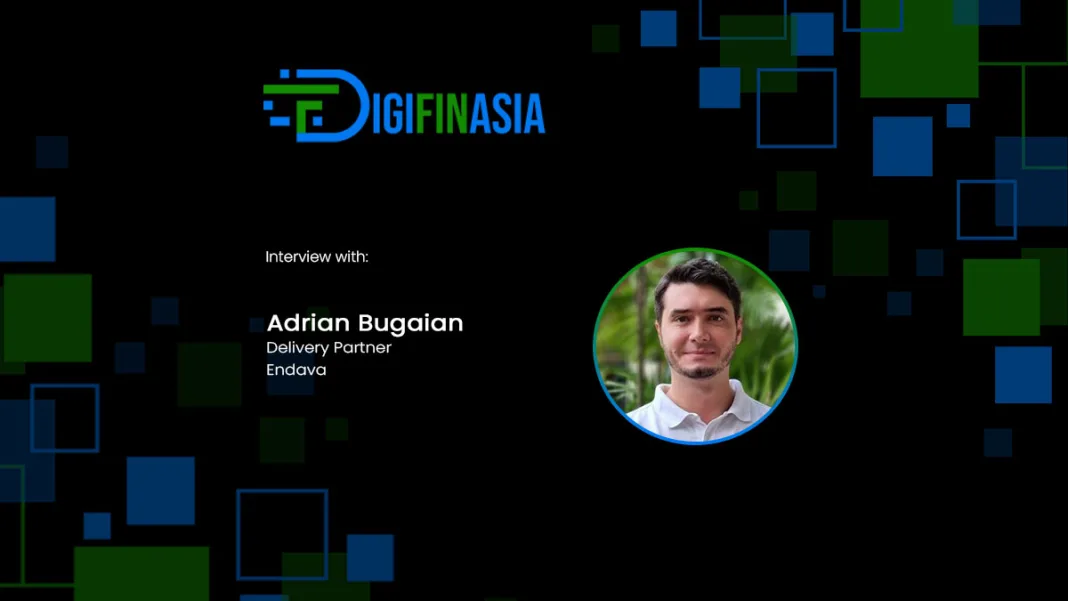Digital banking, digital payments and cloud-native fintechs have transformed the regional financial services landscape, and brought along some key challenges
Digital payments and cybersecurity concerns are becoming increasingly prominent as the APAC market continues to be a strong adopter of such technology.
Business and technology leaders in the finance industry must therefore ensure that their technological capabilities remain agile, backed by the right digital acceleration strategy that will help to bolster customer experiences and build trust.
But are financial institutions in Asia Pacific, including fintechs and digital banks, fully ready to protect themselves and their customers?
DigifinAsia discusses the current regional digital payment landscape with Adrian Bugaian, Delivery Partner, Endava:
What are some major trends in payment and fintech that would impact the Asia Pacific financial sector?
Adrian Bugaian: In the payments space, we expect increased regulation, with the emergence of new payment methods like Buy Now, Pay Later (BNPL) and digital assets becoming increasingly popular. One such example is the Singapore Fintech Association’s (SFA) publication of the code of conduct that outlines strict credit safeguards and clear disclosures to protect users.
As a result, we are seeing more organizations shift their focus to manage complex requirements concerning finance processes, and manage fraud to de-risk exposure. While small and medium sized companies will likely adopt plug-and-play solutions to oversee such processes, larger organizations often manage these changes internally, relying on models like embedded lending, finance and payments. This outsourced support due to increased regulatory load and demand for solutions to support it also spills over to include non-payments companies.
Amidst the increase in digital transactions, financial institutions (FIs) also face a steep increase in customer data breaches. Enhancing cybersecurity measures is another priority within the industry and is a litmus test of trustworthiness and stability.

What developments are impacting cross-border payments in 2023?
Adrian Bugaian: Southeast Asia’s digital economy is slated to hit $330 billion by 2025 and local governments are realizing the importance of enhancing payments connectivity. In fact, a general agreement was signed by ASEAN-5 central banks of Indonesia, Malaysia, Philippines, Thailand and Singapore during the G20 Leader Summit just last year to promote a more inclusive financial ecosystem, acting as a catalyst for the rest of the region to follow suit.
Such support for bolstering payments interconnectivity alongside the development of more innovative solutions will help alleviate customer pain points by speeding up transaction times and lowering additional administrative costs. The closer integration of economies will provide greater convenience for both customers and businesses, enabling a higher flow of eCommerce and financial transactions throughout the region. Cross-border payments will be an essential pillar to support business development, economic recovery, and regional and international trade.
What are some key considerations for financial institutions (FIs) when building an agile digital strategy?
Adrian Bugaian: With data management playing a crucial role in today’s business environment, finding the right strategic partner can make all the difference in a successful digital strategy. Leveraging on the expertise of a specialized team to implement next-generation technology infrastructure can help FIs effectively harness data. Having access to precise insights will increase their competitiveness in the fast-moving digital realm.
Ultimately, FIs must also ensure that they have the right talent in place in order for their digital strategy to be successful. This does not imply that they will require a team of in-house technology experts, rather, it is training employees to adopt a digital-first mindset.
By that, we mean having employees that understand that technology and digital acceleration are core parts of the company vision and strategy, instead of just another external solution to any existing problems the organization may be facing.
At the same time, employees with a digital-first mindset should possess the know-how of utilizing technology in delivering results and driving the main goal of digital acceleration for their customers.
How does digital acceleration help FIs remain competitive?
Adrian Bugaian: Organizations no longer have the technology blank canvas that “transformation” suggests. Digital acceleration, in contrast to traditional digital transformation, assumes that the majority of businesses are already digital or already digitalized to a certain extent. As the term ‘acceleration’ implies constant movement forward, its significance lies in having the organization and its employees always in sync with the company’s perpetual innovations and long-term plans.
To keep up with the rapidly changing digital landscape, many FIs look towards a one-time digital transformation rather than an iterative digital acceleration approach. However, this proves to be insufficient because the process of upskilling and upscaling should be constant as business goals continuously evolve.
As new learnings are applied, having the right digital acceleration strategy can help FIs generate greater competitive edge. Especially as disruptive technology such as AI and quantum computing continue to advance dramatically, increasing consumer demand in innovative solutions will require organizations to evolve their digital offerings.
More importantly, FIs need to strike a balance between expanding the capacity of their businesses’ IT infrastructure utilizing current digital channels and re-engineering the technology infrastructure of their businesses. This guarantees agility and boosts business resilience, enabling them to use technology more efficiently.
By positioning themselves as a trusted player who can keep up with client demands, FIs can ensure that their core business objectives of delivering the best results for customers are met. Through turning challenges into potential opportunities and leveraging the right digital acceleration strategy, FIs stand to thrive and stay ahead of the curve.
Are open banking and digital banking the future of the finance industry? Why?
Adrian Bugaian: Consumers have begun to naturally expect seamless and connected service experiences from all brands they interact with, including their finance providers. Fail to deliver on these expectations and FIs risk losing them to a competitor.
With new mobile payment methods making it easier than ever to spend money, modern FIs – from cloud-native fintechs to digital banks are already capitalizing on these emerging consumer trends. These digital banks are employing AI and data-powered services to speed up loan decisions, empower customers with self-service tools and bring new products to the markets at scale and speed.
Additionally, the prominence of integrated payments paves the way ahead for open and digital banking to develop and mature. For example, many eCommerce platforms are integrating consumer payment services. Having a ‘one-stop-shop’ service via a single umbrella application streamlines personalized consumer experiences. Consumers no longer need to switch between applications, enhancing their mobile shopping experience.
There is no doubt that the finance industry will establish cross-industry partnerships to take such integrations further, be it with the likes of insurance companies or in the healthcare sector.
With data aggregators shifting from screen scraping to data aggregation, there is an increasing number of open banking application programming interfaces (APIs) and real-time payment rails engaging these vendors for active management of monetary transactions. It is likely that more players – be they FIs or non-FIs – will enter the playing field in the near future.



